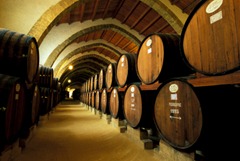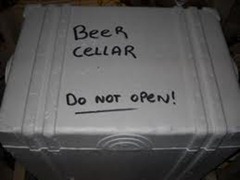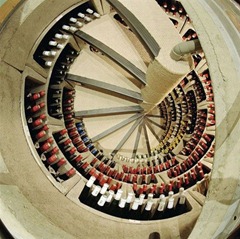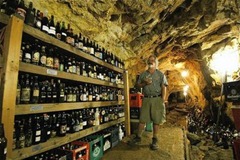
Good heads on old shoulders
The very concept of aged beer goes against many of the things that as beer lovers we hold true. We know that fresh is best and that beer deteriorates with time. But sometimes fresh is not necessarily best, just different to what the same beer may hold flavour-wise with the benefit of time and lots of patience.
The basic truth is that the vast majority of beers are best consumed fresh, as fresh as you can get it. When brewers release a new batch of beer they do so knowing that as it leaves their gates it tastes just the way that they want it to. The hops are singing a perfect melody over the top of a wonderful harmony of malt; time and environmental conditions are yet to strain the beer’s song. This is when they want you to drink their beer – when they know how it will taste.
There are, however, some extraordinary beers that defy this basic brewing tenant and continue to develop in flavour depth over the coming weeks, months, years and even decades in much the same way as some wines do. It is these beers that many beer geeks lust over and spend time waiting for just the right moment to consume. In nearly all cases these beers are perfectly consumable upon release, it’s just that time, patience (yet again) and natural chemical changes can conspire to bring about positive flavour developments that are unobtainable in fresh versions of the same beer.
This flavour development can be more than a little bit contradictory to what we expect in fresh beer. Some of the attributes of aged beer can be things that would put serious marks against a young example. Oxidation and autolysis (yeast breakdown that can produce off-flavours) are seriously frowned upon in fresh beer, yet in small (make that tiny) doses it adds to the depth of complexity in a well-aged brew. So don’t go expecting that 15 year old Special release to “taste the same only better”, it will more than likely have developed into a completely different animal.
Now, this doesn’t mean that a heavily deteriorated old beer is a good one. It is still all about balance – just as we expect in a young brew, only the direction of balance has changed. It is not every beer that is equipped to deal with this change of balance and that is what defines these elite beers.
This all leads to an important question – what sort of beer is suitable for long term storage? No matter how many boxes a beer ticks, there is no guarantee that it will be suitable for long-term storage, but a few general guides are for bigger, harder, faster: high alcohol, high hopping or the use of wild yeast.
High alcohol content (we are talking 7 per cent and up) is a great starting point and the largest number of “cellarable” (is that even a word? … lets make it one!) beers fall into this category. Examples of this include barley wines, imperial stouts, the big Belgians/Belgian-style and many others. However high alcohol does not always mean a good cellar candidate, there are many pasteurised rocket fuel pale lagers out there that are not the tastiest fresh, let alone with the effects of time on board.
High hopping is another area that helps a beer to fall into the “cellarable” class. Barley wines and imperial stouts often fall into this section as well as the more obvious, bigger IPAs such as Murrays Icon and Jamiesons Beast.
When cellaring beers with a big hop profile however, don’t expect the hop profile to remain the same for long. Hop aroma can deteriorate rather rapidly and develop into other flavours or alternatively allow some hidden flavours to show through. There is a side argument in this that ageing an IPA for 6-12months may result in a flavour profile more similar to that which would have been experienced by those drinking the original IPAs after their long voyage from England to India.
As a complete contradiction to the above two categories is the case of the ‘wild’ beers of Belgium – lambics and Flemish red ales. These beers are generally in the five percent ABV ballpark and with bittering levels for Flemish Reds being around the 20 IBU mark (similar to many mainstream lagers) and for Lambics it is only around the five to ten mark. Now for most beers this would place them out of the range of what we consider a cellar candidate, but these beers can be a special case. Gueuze Lambics are a blend of one, two and three year old Lambics and so already have some time on them when they leave the brewery, these beers will continue to develop for a further five years or more. Some Flemish reds are also multi-year blends or vintage releases and they too have similar cellaring abilities. This is due in a large part to the increased acidity level in these beers from the presence of the wild yeast and bacteria that have been a part of their fermentation and maturation. As an indicator of the level of acidity in these beers the pH of many commercial beers is around 4.5, Gueuze Lambics 3.5 and white vinegar around 3.
Whilst all factors may indicate that a beer is a good cellar candidate there is still one more area that can have a bearing on its long term stability – brewing process. All care must be taken in the brewery to ensure that no damage takes place that will rear its ugly head in the beer further down the track. Beers for long term ageing are generally unfiltered, unpasteurised and bottle conditioned – in short “live beers”. However it is possible for “dead beers” to develop as well. J.W.Lees Harvest Ale is both filtered and pasteurised and is considered by many to be one of the classic beers for cellaring. As an 11.5% Barley wine this beer has plenty of areas for component change and development.
So by now we hopefully have an indication of what beers might develop well in our cellar, the next question is “how do we store them?”. The short answer is “cool and dark”. Light is to be avoided at all times in cellaring beer just as it is in all beer, the damage caused by even small amounts of light over a long period will have the same effect as it would if your six-pack of fresh Pils was to sit in the bright sun for an hour – disaster. The next and perhaps most important factor is temperature, an easy way to look at temperature is that warmer temperatures accelerate ageing whilst colder temperatures retard ageing. Ideal temperatures run in the range of 10-15°c and we should consider minimum and maximum to be 5-20°c. It was once pointed out to me by a bio-chemist from the wine industry that if 20°c was considered the base point every 5°c rise is a doubling of speed the product ages. So if we had three bottles stored at 20, 25 & 30°c for 1 year they would have equivalent ages of 1,2 & 4 years. Now this most certainly doesn’t mean that if you age your beer at 35°c you can save yourself a lot of waiting time, other factors come into play and you will end up with a very coarse and crude beer that will most likely have been very adversely effected by deterioration in one or more areas. We are after grace in aged beer, not just old tasting beer. The better way to see this point is that every 5°c results in a halving of the beers potential.
The subject of grace brings another element to the fore: package size. There is a generally held view that larger bottles age more gracefully than their smaller equivalent. This is something that is seen not only in the end bottle but is taken into account in storage by breweries, wineries & distilleries all over the world. So if there is a beer that you would like to put aside and it is available in multiple-sized packages, it may be best to head for the larger rather than smaller format.
There is also much debate amongst collectors of aged beer about whether they should be stored on their side or standing up. Traditionally the ageing of wine or beer has been horizontally in racks but there is much momentum growing for storing beer upright. The “vertical” brigade point out that laying down increases the surface area for oxygen pickup and that upright allows for yeast and other matter to settle firmly on the bottom of the bottle. The “horizontals” counter that with the point that with beer that has been aged for a long time you tend to plan when it will be drunk and so can return the beer to an upright state in advance to allow for settling. It may be worth noting that the Lambic brewers (possibly the most experienced brewers in this area) age their beer on its side. Whichever way you decide to go is up to you, I personally use both methods based on both experimental and space reasons …. I will get back to you with my opinion on the matter in 20 or so years.
Where to actually store your beer depends on how involved you want to get. Small wine cabinets can be purchased for as little as $150. If you intend to go down this path it would be a good idea to block the glass front door with cardboard to minimise light. It would also pay to see one in operation to check on the vibration that the cooling unit may produce, vibration over a long period can also be damaging. Refrigerators tend to keep things too cold and so retard development of beer that you are wishing to see development in, they also may dry out the seal in beers that finished with a cork closure.
You don’t however need to go to the expense of a dedicated cabinet. The back of a cupboard in the centre of the house has been used by many to cellar successfully, with some even using eskies for added insulation. The key is to try to keep temperatures cool (but not cold) and stable.
When to drink is all up to you, but remember that eventually the beer will hit a peak and start to decline in positive flavours. Sometimes this decline will end up being overcome as the beer turns into a new direction but usually it means the end of a tasty beer and instead just becomes an “interesting” beer. For this reason it is best to buy multiple bottles and evaluate them periodically as they age.
Just remember that in order to meet its “Beery Karma” every beer must eventually be drunk… eventually.
Beers available in Australia that may be good candidates for ageing.
- Thomas Hardy Ale
- Durham Temptation
- Unibroue Trois Pistols
- Chimay Blue (Grand Reserve)
- Rochefort 10
- Rodenbach Grand Cru
- Redoak Special Reserve
- Grand Ridge Supershine
- Murrays Anniversary Ale
- Crown Ambassador Reserve
- Coopers Vintage Ale
Beers to look out for
- Old vintages of Thomas Hardy Ale
- Courage (UK) Russian Imperial Stout
- Courage (Aus) Anniversary Ale
- Hahn Special Vintage (1999 & 2000)







